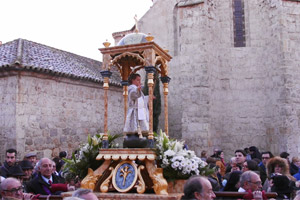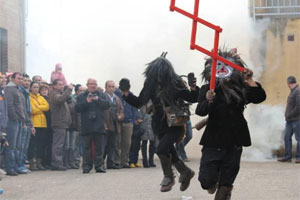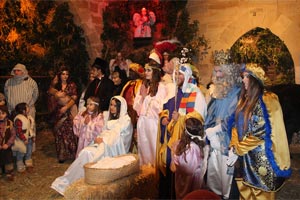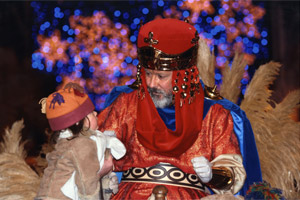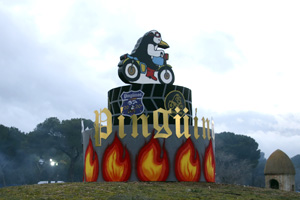Easter Week in Cuenca
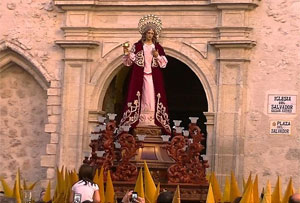
Why Cuenca's Holy Week will surprise you
Easter Week in Cuenca is one of the most important religious celebrations in Spain and has been declared a World Heritage Site by UNESCO. It takes place during the week leading up to Easter Sunday and involves the participation of 33 brotherhoods and confraternities who parade through the streets of the city with their processional floats.
What is most striking about Easter Week in Cuenca is the beauty and spectacular nature of its processions, many of which are authentic works of art. Furthermore, the processions take place in an incomparable setting, as the narrow, steep streets of the city's old quarter become the perfect backdrop for this impressive parade of faith and devotion.
Another of the most exciting moments of Holy Week in Cuenca is the so-called "Encuentro", which takes place on Good Friday. At this moment, the images of Jesus and the Virgin meet in Alfonso VIII Street, in a moment of great emotion for the faithful.
A unique experience that will not leave you indifferent due to its devotion, beauty and spectacular nature.
Holy Week Processions in Cuenca
During Holy Week in Cuenca, numerous processions take place in which the different brotherhoods and confraternities of the city take part. These processions take place in the historic centre of Cuenca and are characterised by the solemnity and emotionality of their processions.
One of the most outstanding processions is the "Sermón de las Siete Palabras" (Sermon of the Seven Words), which takes place on Good Friday. In it, the seven words that Jesus pronounced on the cross before dying are heard, and a procession takes place in which the images of the Virgen de la Amargura and the Cristo del Perdón (Christ of Forgiveness) take part.
Another very important procession is that of the "Encuentro", which also takes place on Good Friday. In it, the images of the Recumbent Christ and the Virgin of Solitude meet in Calle Alfonso VIII, in a moment of great emotion for the faithful.
The procession of the "Resucitado" (Risen Christ) is another of the highlights of Easter Week in Cuenca, which takes place on the morning of Easter Sunday. In it, the moment when Jesus rises from the dead is represented and there is a procession in which the image of the Resurrected Christ and the Virgin of Joy take part.
In addition to these processions, there are many others in which different brotherhoods and confraternities of the city take part, each with their own images and processional rites. Easter Week in Cuenca is, in short, a unique experience in which the religiosity, history and beauty of this beautiful Castilian city are combined.
Origin and history of Easter Week in Cuenca
The origin of Holy Week in Cuenca dates back to the 16th century, although its roots could be earlier. Although it is not known with certainty when the processions began to be held, it is known that the first public processions were already taking place in the 17th century.
During the 18th and 19th centuries, Holy Week in Cuenca acquired greater importance and the first chapels and altars for the processional floats began to be built. In the 20th century, Holy Week in Cuenca became one of the most important religious celebrations in Spain and began to attract thousands of visitors every year.
Nowadays, Holy Week in Cuenca is one of the most important and renowned in Spain, thanks to the beauty and spectacularity of its processions, the artistic richness of its processional floats and the devotion of its members and faithful.
In 1980, Easter Week in Cuenca was declared a Festival of National Tourist Interest, and in 2019 it was declared Intangible Cultural Heritage of Humanity by UNESCO, in recognition of its cultural and religious importance.
What to visit in the city of Cuenca
Cuenca is a city with a rich historical and cultural heritage that offers numerous options for the visitor. Here are some of the most outstanding places to visit in the city:
- Historic quarter: Cuenca's historic quarter is one of the most beautiful in Spain and has been declared a World Heritage Site by UNESCO. Its narrow, steep streets, its hanging houses and its cathedral, among other monuments, stand out.
- Cathedral of Santa María and San Julián: Cuenca Cathedral is one of the most important in Castile-La Mancha and presents an interesting mixture of Gothic, Renaissance and Baroque styles. Its magnificent façade, cloister and tower, from which you can enjoy spectacular views of the city, are outstanding.
- Museum of Spanish Abstract Art: This museum, housed in an 18th century palace, is one of the most important of its kind in Spain and has an impressive collection of works by Spanish abstract artists such as Antonio Saura, Eduardo Chillida and Pablo Serrano.
- Cerro del Socorro viewpoint: From this viewpoint, located on the outskirts of the city, you can enjoy an impressive panoramic view of Cuenca and its natural surroundings.
- Bridge of San Pablo: This medieval bridge, which crosses the river Júcar, is one of the symbols of the city of Cuenca and offers a spectacular image from the hanging houses of the historic quarter.
- Barrio del Castillo: This neighbourhood, located in the upper part of the city, is one of the oldest and most picturesque in Cuenca and has numerous monuments, such as the Mangana Tower, the Convent of Las Petras or the Church of San Pedro.
These are just some of the most outstanding places to visit in the city of Cuenca. The city offers many more options for visitors, such as the Castile-La Mancha Science Museum and the Medieval Cities Interpretation Centre.
Near the city, if you have the chance, you should not miss it:
- The Enchanted City of Cuenca is a natural spot located in the Cuenca Mountains, some 25 kilometres north of the city of Cuenca. It is a protected natural area that is home to curious and spectacular rock formations, the result of the action of wind, water and other erosive agents over millions of years. The rock formations take on capricious and strange shapes, which have been baptised with names such as "the face of man", "the dog", "the ships" or "the lovers of Teruel", among others. The Enchanted City is one of the most visited and emblematic places in the province of Cuenca and a must for nature and photography lovers.
Crafts and recommended shopping
The city of Cuenca is known for its rich handicraft tradition, especially in the field of ceramics and jewellery. Here are some of the typical souvenirs and handicrafts of Cuenca that you could buy during your visit:
- Ceramics: Ceramics is one of the most characteristic handicrafts of Cuenca. You will be able to find ceramic pieces of different sizes, shapes and colours, such as plates, vases, cups, tiles, etc. Talavera pottery is particularly noteworthy, in Renaissance style and characterised by its bright colours and geometric designs.
- Jewellery: Jewellery is another of Cuenca's most outstanding crafts. You can find jewellery made of silver, gold and other precious metals, with original and elegant designs, inspired by nature and the cultural heritage of the region.
- Bobbin lace: Bobbin lace is a handcrafted technique used to create decorative pieces of fabric, such as scarves, towels or tablecloths. In Cuenca, this technique is very popular and you will find different pieces made with this technique in craft shops.
- Carpets: During Holy Week in Cuenca, beautiful carpets of flowers and sawdust are made in the streets of the city to decorate the route of the processions. Some craft shops offer replicas of these carpets, as well as other textile pieces.
- Typical sweets: Cuenca has a very rich gastronomic tradition, in which typical sweets stand out. These include almendras garrapiñadas, pastelillos de gloria, perrunillas and sequillos.
In the city you will find numerous craft and gastronomy shops where you can buy these and other local products.
Popular gastronomy in Cuenca
The gastronomy of Cuenca is a fusion of influences from La Mancha and Cuenca, with tasty and hearty dishes characterised by the use of local and seasonal ingredients.
Here are some of the most popular dishes of Cuenca's gastronomy:
- Morteruelo: This is one of the best-known dishes in Cuenca's cuisine. It is a stew made with game meat, pork liver, bread, spices and other ingredients that are ground and mixed in a mortar to obtain a fine dough that is cooked over a low heat. It is usually served as a starter or main course.
- Zarajos: Zarajos are a typical speciality of the La Mancha area, although they are also eaten in Cuenca. They are lamb tripe that is cleaned and marinated with garlic, parsley and other seasonings before being grilled. It is a very tasty and crunchy dish that is usually eaten as a tapa.
- Atascaburras: This is a typical Easter dish from Cuenca that is made with potatoes, desalted cod, garlic and olive oil. Everything is mashed and mixed until a homogeneous mass is obtained and served cold, accompanied by hard-boiled egg, olives and walnuts.
- Pisto conquense: This is a stew made with vegetables such as courgette, aubergine, pepper and tomato, which is simmered and served hot as a main dish or as an accompaniment to other dishes.
- Alajú: This is a typical sweet from Cuenca that is made with honey, almonds, hazelnuts, dried figs and other ingredients that are mixed and baked. It is a very tasty and nutritious sweet that is usually eaten as a dessert.
These are just a few examples of the rich gastronomy of Cuenca. If you stroll around Cuenca you will find numerous restaurants and bars where you can try these and other typical dishes of the region.

